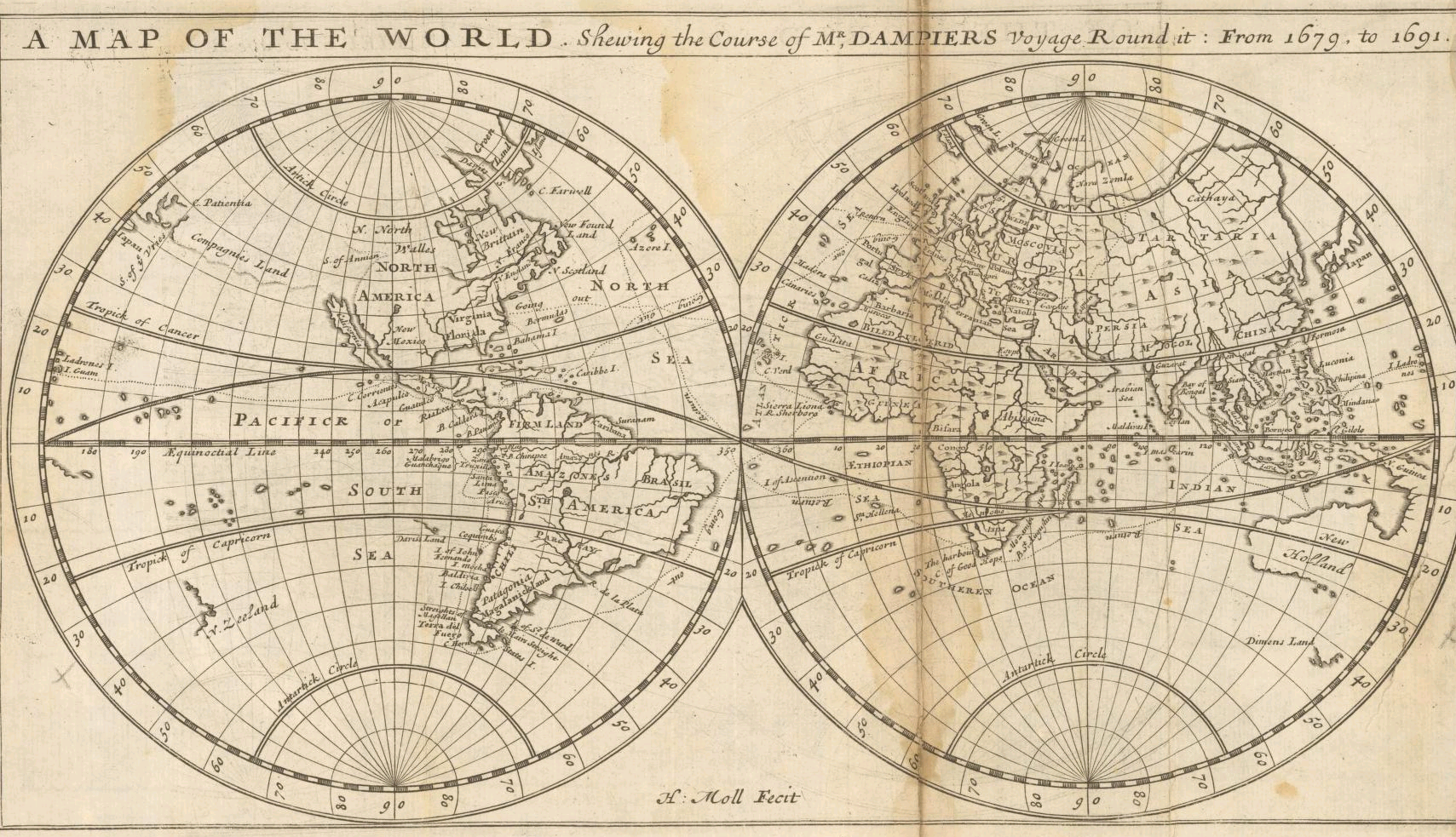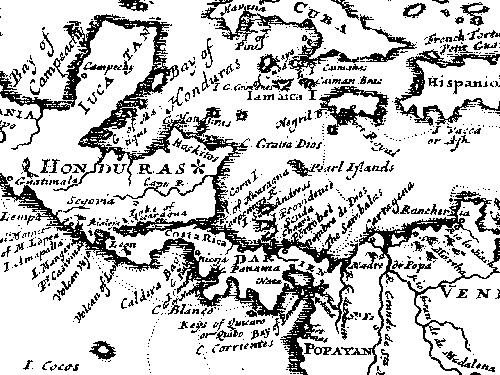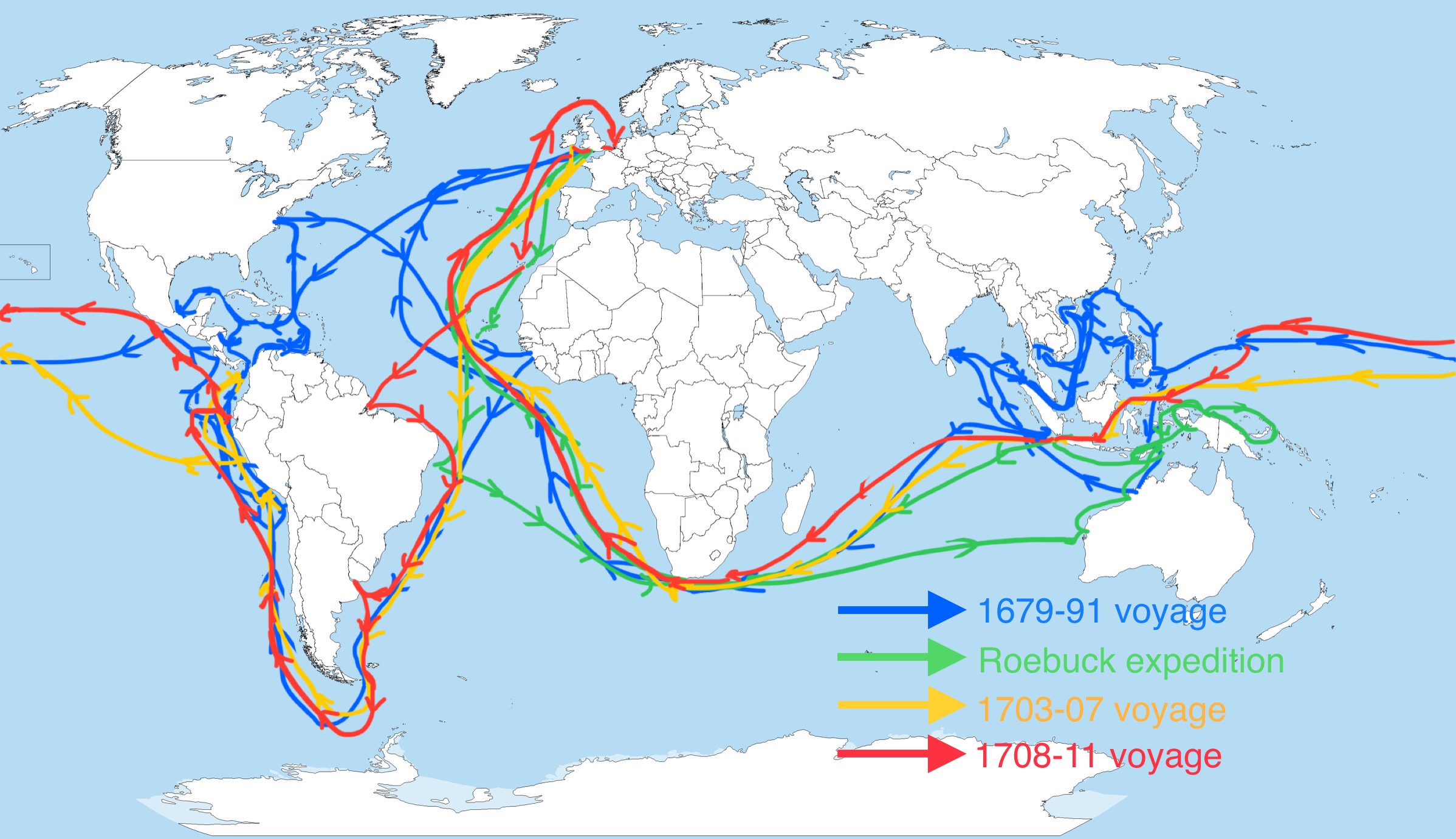1. Early Life
William Dampier was born at Hymerford House in East Coker, Somerset, England, in 1651, and was baptised on 5 September. His precise date of birth is not recorded. He received his education at King's School, Bruton.
Dampier embarked on his maritime career as a teenager, sailing on two merchant voyages. His first took him across the Atlantic Ocean to Newfoundland, and his second voyage brought him to Java. In 1673, he joined the Royal Navy and participated in the two Battles of Schooneveld in June of that year during the Third Anglo-Dutch War. His service was cut short due to a catastrophic illness, which necessitated his return to England for several months of recuperation. For the subsequent years, Dampier pursued various careers, including plantation management in Jamaica and logging in Mexico. It was during this period that he began keeping detailed journals, which would later form the basis of his writings, such as Voyages to Campache and Discourses of Winds, the latter drawing on his experience of a severe storm. Returning to England around 1679, he married Judith, but departed for the sea just a few months later.
3. Roebuck Expedition (1699-1701)
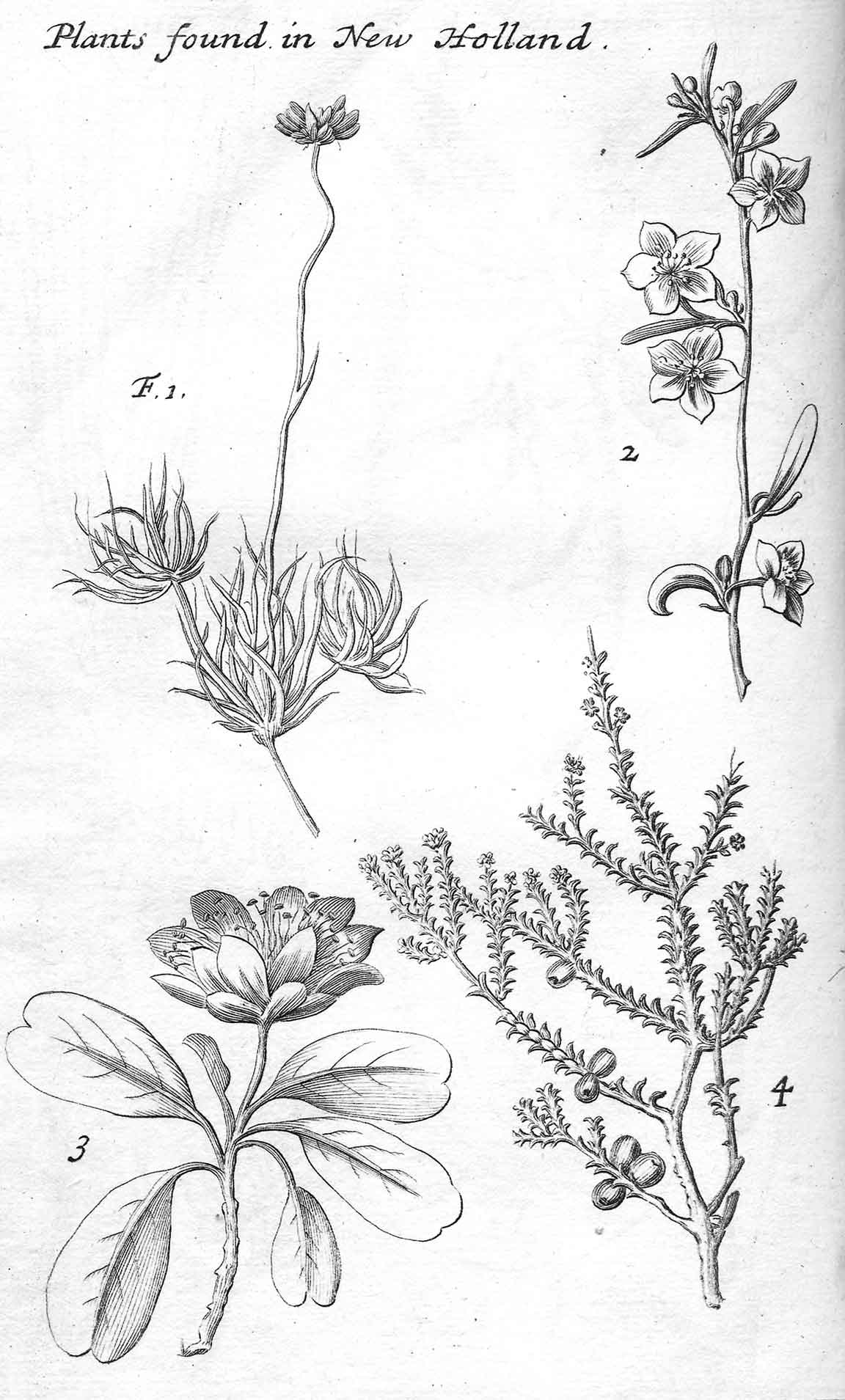
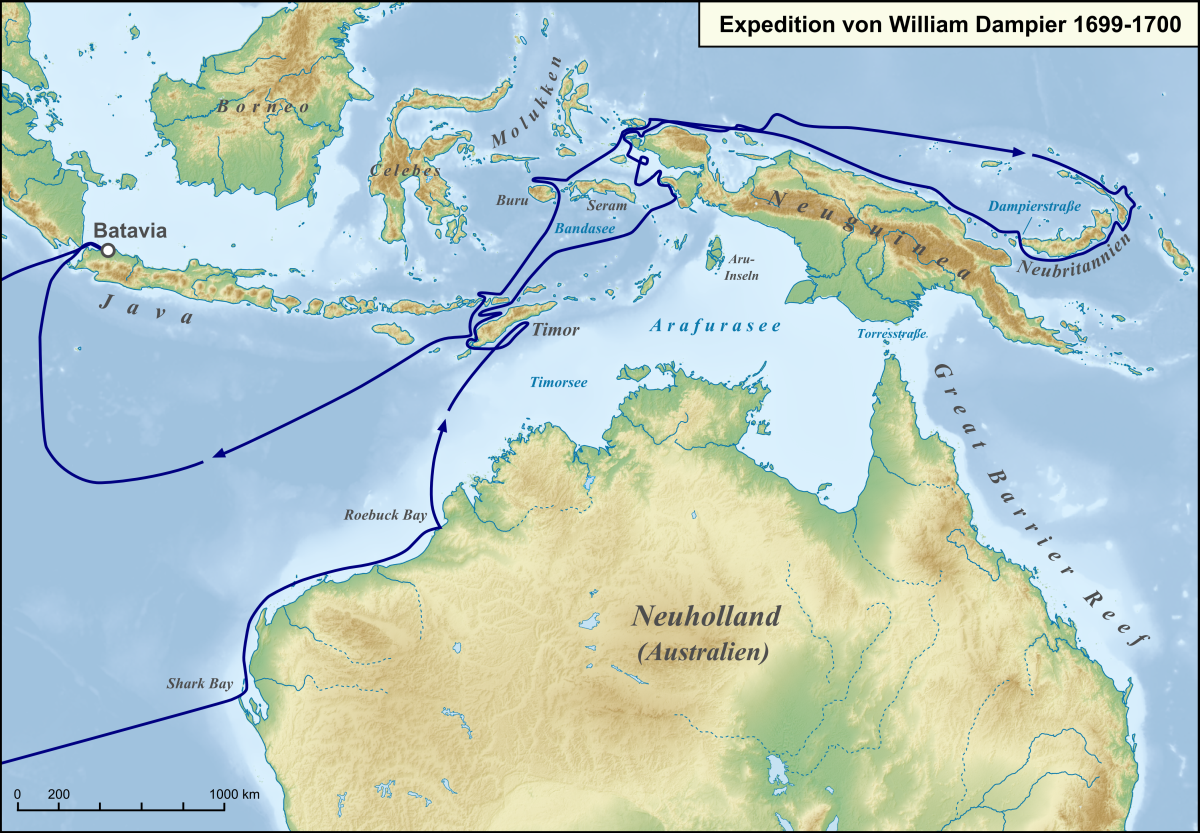
The publication of Dampier's book, A New Voyage Round the World, in 1697 was a popular sensation, capturing the interest of the British Admiralty. In 1699, Dampier was given command of the 26-gun warship HMS Roebuck, with a commission from King William III. His primary mission was to explore the east coast of New Holland, the name given by the Dutch to what is now Australia. Dampier initially intended to reach New Holland via Cape Horn.
The expedition set sail on 14 January 1699. Due to the lateness of the season for attempting the Horn, they instead headed to New Holland via the Cape of Good Hope. Following the established Dutch route to the Indies, Dampier navigated between Dirk Hartog Island and the Western Australian mainland, entering what he named Shark Bay on 6 August 1699. He landed there and began to produce the first known detailed record of Australian flora and fauna, with botanical drawings believed to be by his clerk, James Brand. Dampier then proceeded to follow the coast northeast, reaching the Dampier Archipelago and Lagrange Bay, just south of what is now called Roebuck Bay. Throughout this journey, he continued to meticulously record and collect specimens, including numerous shells. From there, he bore northward for Timor.
He then sailed east, and on 3 December 1699, rounded New Guinea, passing to its north. He meticulously traced the southeastern coasts of New Hanover, New Ireland, and New Britain, meticulously charting the Dampier Strait between these islands (now part of the Bismarck Archipelago) and New Guinea. During this leg of the voyage, he paused to collect various specimens, such as giant clams.
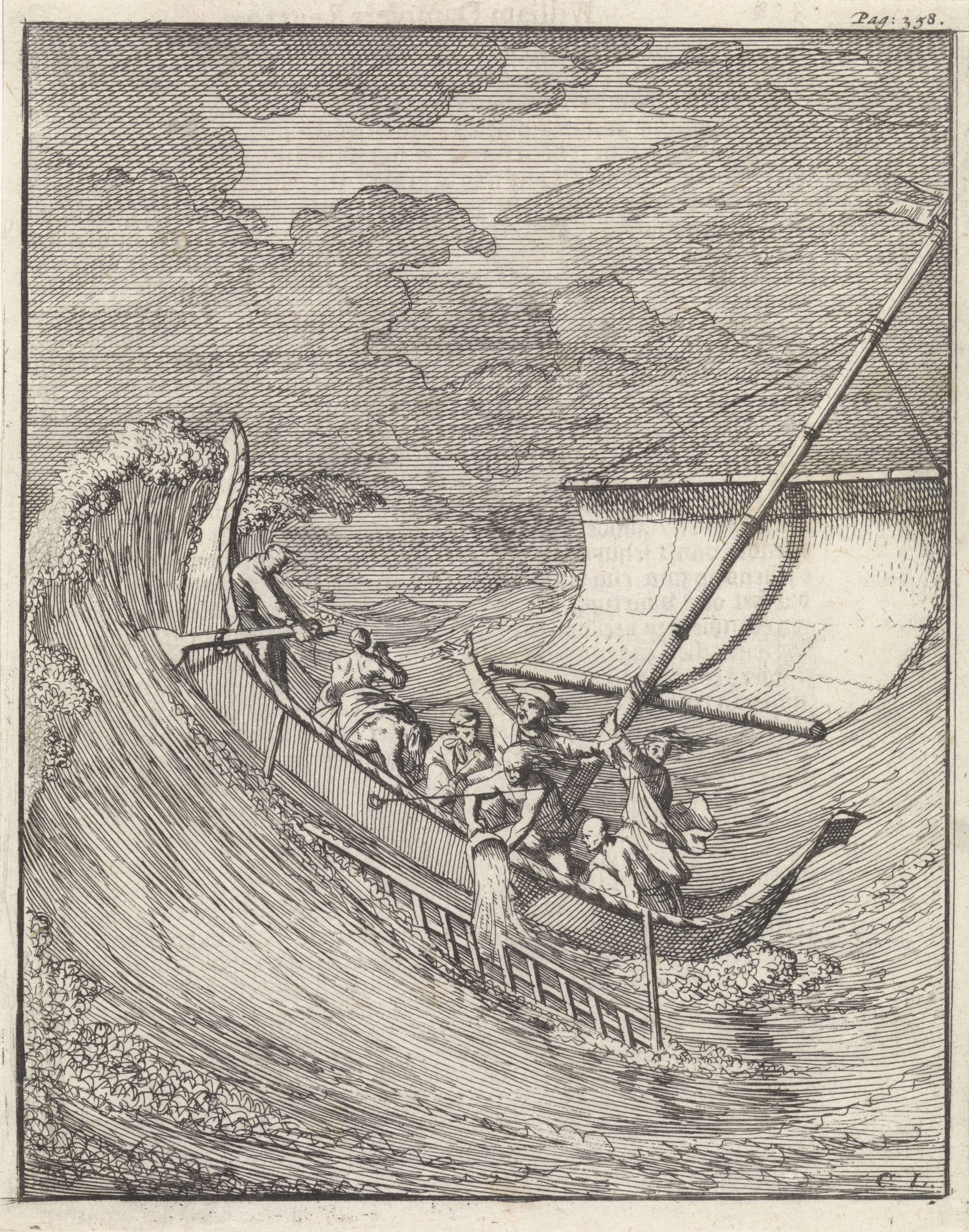
By this point, Roebuck was in such a deteriorated state that Dampier was forced to abandon his plan to fully examine the east coast of New Holland, despite being less than 100 mile from it. With the ship in danger of sinking, he attempted the return voyage to England, but the vessel foundered at Ascension Island on 21 February 1701. While anchored offshore, the ship began to take on more water, and the carpenter was unable to repair the worm-eaten planking. Consequently, the ship had to be intentionally run aground. Dampier's crew was marooned on the island for five weeks before being rescued on 3 April by an East Indiaman and subsequently returned to England in August 1701.
Although many of the expedition's papers were lost with Roebuck, Dampier managed to save some new charts detailing coastlines, along with his valuable records of trade winds and currents in the seas around Australia and New Guinea. He also preserved a few of his scientific specimens. Many of these plant specimens were later donated to the Fielding-Druce Herbarium (part of the University of Oxford), and in September 1999, they were temporarily loaned to Western Australia for a 300-year celebration of his voyage.
In 2001, the wreck of the Roebuck was successfully located in Clarence Bay, Ascension Island, by a team from the Western Australian Maritime Museum. Given Dampier's widespread historical influence and the scarcity of tangible items directly linked to him, it has been argued that the remains of his ship and the objects still at the site on Ascension Island-while the property of Britain and subject to the island government's management-represent a shared maritime heritage for the regions of the world he first visited or described. His detailed account of this expedition was published as A Voyage to New Holland in 1703.
4. Court Martial
Upon his return from the Roebuck expedition, Dampier was court-martialled on charges of cruelty. During the outward journey, Dampier had ordered his lieutenant, George Fisher, to be removed from the ship and jailed in Brazil. Fisher subsequently returned to England and lodged a formal complaint about his treatment with the Admiralty.
Dampier vehemently defended his conduct, but the court ultimately found him guilty of the charges. As a consequence, his pay for the voyage was reduced, and he was dismissed from the Royal Navy.
According to records held at the UK's National Archives, the Royal Navy court-martial, held on 8 June 1702, addressed the following three charges:
- William Dampier, Captain, HMS Roebuck.
- Crime: Death of John Norwood, boatswain.
- Verdict: Acquitted.
- William Dampier, Captain, HMS Roebuck.
- Crime: Hard and cruel usage of the lieutenant (George Fisher).
- Verdict: Guilty.
- Sentence: Forfeit all pay due and deemed unfit to command any of His Majesty's ships.
- George Fisher, Lieutenant, HMS Roebuck
- Crime: Dispute between the captain and the lieutenant.
- Verdict: Acquitted.
7. Literary and Scientific Works
William Dampier was a prolific writer whose publications significantly shaped geographical knowledge, natural history, and travel literature of his time. His major works include:
- A New Voyage Round the World (1697): This book was a popular sensation, drawing the attention of the British Admiralty and leading to his command of HMS Roebuck.
- Voyages and Descriptions (1699)
- A Supplement of the Voyage Round the World (1705)
- The Campeachy Voyages (1705)
- A Discourse of Winds (1705)
- A Voyage to New Holland (Part 1 1703, Part 2 1709): This detailed account documented his expedition to Australia and New Guinea.
- A Continuation of a Voyage to New Holland (1709)
Dampier's writings were groundbreaking for their time. His expeditions allowed him to be among the first to identify and name a variety of plants, animals, foods, and cooking techniques for a European audience. He was also among the first English writers to use words such as "avocado," "barbecue," "chopsticks," and "subspecies" in his prose. Notably, in describing the preparation of avocados, he provided the first European account of the making of guacamole. He also named the breadfruit plant and frequently documented the taste of numerous foods that were exotic to the European palate at the time, including flamingo and manatee. He also recorded the first English language recipes for guacamole and mango chutney.
8. Legacy and Influence
Dampier's influence extended across various fields, impacting figures and disciplines far beyond his own time:
- Navigation**: He made significant contributions to navigation by collecting, for the first time, extensive data on currents, winds, and tides across the world's oceans. This invaluable information was later utilized by renowned explorers such as James Cook and Joseph Banks.
- Natural Sciences**: His detailed notes on the fauna and flora of northwestern Australia were extensively studied by the naturalist and scientist Joseph Banks. These studies contributed to the naming of and subsequent colonization efforts at Botany Bay, ultimately playing a role in the founding of modern Australia. Furthermore, Dampier's observations and analyses of natural history helped to inform and advance the scientific theories developed by prominent figures like Alexander von Humboldt and Charles Darwin. His observations, along with those of William Funnell, during his expeditions are also mentioned multiple times by Alfred Russel Wallace in his book The Malay Archipelago, where Wallace compares them to his own observations from his 19th-century voyages. The Australian flowering plant genus Dampiera is named in his honor.
- Literature**: Dampier's travel accounts profoundly influenced several literary figures. Jonathan Swift mentions Dampier in his Gulliver's Travels as a mariner comparable to Lemuel Gulliver, and the novel itself occasionally parodies Dampier's travel books and other tales of exploration. His former crewmate, Alexander Selkirk, who was marooned on an island, is widely believed to have been the real-life inspiration for Daniel Defoe's iconic novel Robinson Crusoe. Samuel Taylor Coleridge, who read Dampier's A New Voyage Round the World, referred to him as "a rough sailor, but a man of exquisite mind." Dampier's observations on marine life were among the many sources that Coleridge drew upon for inspiration while composing his poem The Rime of the Ancient Mariner. His detailed reports on the breadfruit plant also influenced William Bligh and the ill-fated voyage of HMS Bounty, leading to the Mutiny on the Bounty.
- Lexicography**: Dampier is cited over 80 times in the Oxford English Dictionary, notably for words such as "barbecue", "avocado", "chopsticks", and "subspecies". While he did not necessarily coin these words, his use of them in his writings represents the earliest known examples in English.
- Cultural Depictions**: His life and adventures have been dramatized in various forms. He was the subject of the 1954 Australian radio play Gulliver's Cousin by Ruth Park, where Dampier was originally played by Rod Taylor. He is also mentioned by Nobel Prize in Literature winner Gabriel García Márquez in his novel "The Autumn of the Patriarch." More recently, his adventures have been adapted into the Japanese manga Dampier no Oishii Boken (2019-2023) and featured in the musical reading play El Galleon ~El Galleon~ (2020), where William Dampier was played by Yūichirō Umehara.
9. Criticism and Controversy
Despite his significant contributions to exploration and scientific knowledge, William Dampier's career is marked by notable criticisms and controversies, particularly concerning his conduct towards his crew and indigenous peoples.
One of the most prominent controversies was his court-martial for cruelty following the Roebuck expedition. As detailed in the "Court Martial" section, Dampier was found guilty of "hard and cruel usage" towards his lieutenant, George Fisher, whom he had removed from the ship and jailed in Brazil. This verdict resulted in the forfeiture of his pay for the voyage and his dismissal from the Royal Navy, publicly tarnishing his reputation and casting a shadow over his naval command.
Beyond his treatment of crewmembers, Dampier's actions regarding indigenous populations have drawn severe criticism, particularly in modern interpretations. His voyage accounts reveal a troubling pattern of kidnapping and exploiting indigenous peoples for personal profit and public display. The most well-documented instance involves a young man known as Jeoly, from Miangas. Dampier acquired Jeoly, who had been enslaved by traders, and later sold him to an inn in London for exhibition. Jeoly was displayed as a "prince" to large audiences eager for entertainment, until his death from smallpox just three months later. This act highlights the ethical concerns surrounding his participation in the human trafficking and commodification of indigenous individuals. Furthermore, Dampier's own writings contain dehumanizing descriptions of indigenous peoples, such as his characterization of Aboriginal Australians as "miserablest" people who "differ but little from brutes," reflecting a prejudiced worldview common at the time but now widely condemned.
10. Honours
William Dampier's historical significance is recognized through various geographical locations, celestial bodies, and other commemorations named in his honor:
- Geographical Features in Australia**:
- Dampier: A town and major industrial port in the Pilbara region of northwestern Western Australia.
- Dampier Creek: Located in Roebuck Bay, Broome, Western Australia.
- Dampier Archipelago: An island group off the coast of Western Australia.
- Dampier Island: An island of the Dampier Archipelago, renamed Burrup Peninsula in the 1960s when it was connected to the mainland by a causeway.
- Dampier Land District: A cadastral division of Western Australia.
- Dampier Peninsula: A peninsula in Western Australia.
- Global Geographical Features**:
- Dampier County: A cadastral division of New South Wales.
- Dampier Ridge: Part of the submerged continent of Zealandia.
- Mount Dampier: The third highest peak in New Zealand.
- Dampier Seamount: Located off the island of Saint Helena.
- Dampier Strait (Indonesia): A strait in Indonesia.
- Dampier Strait (Papua New Guinea): A strait in Papua New Guinea.
- Other Honours**:
- The Division of Dampier: An electorate of the Australian House of Representatives from 1913 to 1922.
- The minor planet 14876 Dampier.
- The British frigate/survey ship HMS Dampier, in service with the Royal Navy between 1948 and 1968.
- Postage stamps bearing his portrait issued by Australia Post in 1966 and 1985.
